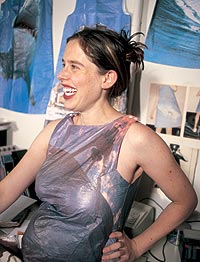 |
Body
Art
Paper dresses with iconic images have made Sarah Caplan
a fashion poster child.
by
Lauren Parker
photos
by Marina Berio '88
  Working
from her Manhattan design studio, a pregnant Sarah Caplan '88
proves that her innovative paper wardrobe doubles just fine
as maternity wear. An Oberlin art major-turned-clothing designer,
Caplan has created a respected niche in the fashion world with
her wearable, bold, postmodern dresses that speak volumes about
our society. Her clothing line, which evolved from poster dresses
to jackets, vests, and skirts, has attracted reviews in dozens
of media outlets. Even the esteemed Fashion Institute of Technology
houses her works in its museum's permanent collection--not bad
for an artist with little professional fashion experience. Working
from her Manhattan design studio, a pregnant Sarah Caplan '88
proves that her innovative paper wardrobe doubles just fine
as maternity wear. An Oberlin art major-turned-clothing designer,
Caplan has created a respected niche in the fashion world with
her wearable, bold, postmodern dresses that speak volumes about
our society. Her clothing line, which evolved from poster dresses
to jackets, vests, and skirts, has attracted reviews in dozens
of media outlets. Even the esteemed Fashion Institute of Technology
houses her works in its museum's permanent collection--not bad
for an artist with little professional fashion experience.
"I
remember photocopying a 1960s picture of a woman wearing a
paper dress with an image of Bob Dylan on the front, which
I had found in a book in the art museum library at Oberlin,"
Caplan says. "Thirteen years later I still have the print
and keep it on my wall for inspiration."
Caplan
put a millennial spin on the concept first introduced by
Scott Paper Company in 1966 to promote colored toilet paper
and paper towels. Half a million op-art and psychedelic-patterned
paper dresses sold for $1.25 apiece, igniting a fad that
even the Duchess of Windsor embraced.
A
paper-thin concept? Hardly. The disposable dresses of the
'60s were part of a much broader social movement. As we
evolved into a use-and-toss society, consumers became accustomed
to throwaway cutlery, diapers, and containers. Why not throwaway
fashion? While strolling through New York City eight years
ago, Caplan stumbled upon a street vendor selling one of
these vintage paper poster dresses for a mere $2. "They
were worth up to $1,000 at the time based on a Sotheby's
auction," she exclaims. "And that was before eBay!"
She
wore her acquisition to a museum opening and was photographed
by fashion trendwatcher Bill Cunningham for The New York
Times style section. "The dress had a huge image of a woman's
eye," she says. "I just couldn't believe the response it
got."
 The
experience inspired her to reinvent the design classic for
the millennial set. She ditched the original disposable
paper for Tyvek, a biodegradable, water-resistant, high-density
polyethylene manufactured by DuPont that is surprisingly
durable (ever try to rip a FedEx envelope?) and machine
washable. The fabric gets softer and more wrinkled with
each wear and wash, but it lasts. Perfect for a population
that has replaced the word disposable with recyclable. The
experience inspired her to reinvent the design classic for
the millennial set. She ditched the original disposable
paper for Tyvek, a biodegradable, water-resistant, high-density
polyethylene manufactured by DuPont that is surprisingly
durable (ever try to rip a FedEx envelope?) and machine
washable. The fabric gets softer and more wrinkled with
each wear and wash, but it lasts. Perfect for a population
that has replaced the word disposable with recyclable.
She
kept the original design, an A-line cut, which is deliberately
simple and offers a wide canvas for the attention-grabbing
pictures, but flowers and psychedelia were replaced with
powerful images reflective of a bigger, faster mentality:
a satellite dish, an opened-mouth shark, the World Trade
towers, a lightning storm, and a surfer cresting a massive
wave. "It's all about speed now," Caplan says. "Things are
spinning out of control with technology and communications.
Time is out of balance."
To
suit, she named her company MPH (Miles Per Hour), emphasizing
that her designs are abstract art items first, articles
of clothing second. "This project was more of an artistic
endeavor than pure fashion design," she says. "While fashion
wasn't my number one priority in college, I always felt
it had an undeniable seductive power and could be used just
as any medium can to express artistic notions. Oberlin had
a great art department and really encouraged me to question,
think critically, delve, push the boundaries.
"I
wanted these dresses to be conceptual; something with an
idea behind them," she adds. "Not something that changed
with the whims of fashion."
An
issue of Financial Times last year credited Caplan with being
well ahead of the trend, citing a recent Paris exhibition,
Papiers a la Mode, which displayed intricate dresses made
entirely of paper. Caplan's creations sell at retail stores
in New York and through her website (www.mph-nyc.com).
For
her next designs she has several ideas, working with advertising
images among them. "I find advertising annoying, as it's
so ubiquitous. Even New York City has buckled and now allows
billboards to invade what was a pristine urban landscape."
Ads,
she says, have been boiled down to stark, recognizable imagery
("think Marlboro Man or the Nike swoosh") that need no words
or explanation. "Advertising has replaced art in its power
to sway, manipulate, and seduce us. In many cases, the ads
are confusing, yet the public has an instant, visceral response
and wants to buy into the fantasy.
"For
me, using these images on my dresses would be a commentary
on what powers are at play in our lives, what guides us
in our consumer-based culture."
Lauren
Parker is the executive
editor of Smock, a glossy publication that fuses contemporary
art with fashion, style, and design.
|

